► BYD Seal vs Hyundai Ioniq 6
► Two electric streamliners tested
► Which is the better EV saloon?
As much as you try to be fair when reviewing cars, a few preconceptions are inevitable. Take the BYD Seal, a keenly priced if not downright cheap four-door executive saloon. Prior experience with some of the Chinese manufacturer’s other products suggested I’d be in for soggy body control, annoying assistance systems and anodyne handling. Just how wrong can you be?
Giving the accelerator pedal a little squeeze coming out of a T-junction I feel the rear of the car start to carve a wider arc than the front. It’s a fleeting moment of sideways that’s easily gathered up, but it’s enough to suggest the Seal might have more of a sense of humour than I’d thought.
And relaxing into its plush cabin, it’s easy to forget that until very recently there was very little on offer from any Chinese car maker that could fairly be described as luxurious.
Yet here we are, testing the BYD saloon against a car that we rate highly, the Hyundai Ioniq 6 from in-form South Korea. Is this really a like-for-like comparison that the BYD stands a chance of winning?
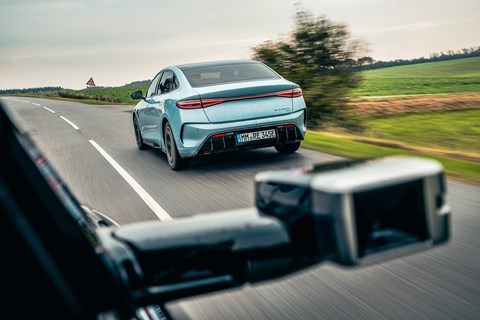
Our Seal is the top-of-the-range dual-motor Excellence AWD version that offers a mighty 523bhp, or not far off the much pricier BMW i4 M50. Even so, a 3.8-second 0-62mph time just pips the i4’s 3.9, and the Seal’s standard kit list is far more extensive. The Seal is longer than the i4 and the Tesla Model 3, making it more of a direct rival for the Ioniq 6. The 6 is a more expensive option that isn’t as fast – 0-62mph takes a still brisk 5.1 seconds – but it is slightly bigger and more efficient.
Our Ioniq 6 is a Long Range AWD Ultimate. Its battery is slightly smaller than the Seal’s, but the Hyundai’s extra energy efficiency means its range is near identical: 322 miles for the Korean car, 323 for the Chinese newcomer.
The Ioniq 6 taps into the Hyundai Motor Group’s electric expertise to offer faster charging times and the ability to take a far stronger rapid charge rate. On a 350kW charger, you can get from 10 per cent full to 80 per cent in a mere 18 minutes. Admittedly, you won’t find many 350kW units, and even when you do they’ll often fail to deliver full power, for a variety of reasons including temperature or demand from other chargers in the vicinity, but it’s always a pleasing bonus when you get lucky.
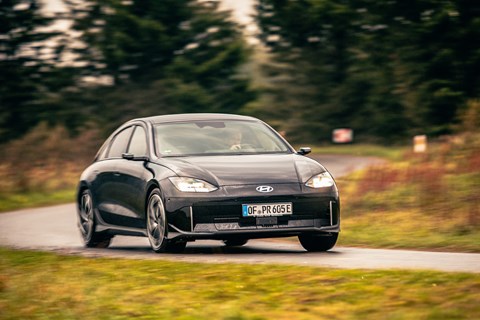
The Ioniq 6 is also equipped to take advantage of 11kW Type 2 chargers such as those found in some workplaces, designed to get you back up to 100 per cent charge easily within the working day. So too is the Seal, but its rapid charging capability is some way short of the Ioniq’s, at up to 150kW. Nonetheless, that’s better than plenty of EVs, and gives a 37-minute time from 10 to 80 per cent.
Both cars also come with ‘vehicle to load’ (or V2L) capability that allows you to charge external items via a built-in socket for a three-pin plug. The Ioniq can support up to 3.6kW and the Seal 3kW, making them a handy addition to a camping trip or other outdoor activities. You’ll need a roofbox or cycle rack to put these cars at the centre of your leisure plans, though. Both are traditional saloons with a boot rather than a rear hatch, and not a vast amount of luggage space. The Seal has 400 litres behind the rear seats and another 53 litres under the bonnet, while the Ioniq has 401 and just 15 litres respectively. Both also come with 60/40 split folding rear seats, making it possible to carry longer items in the boot by having them intrude into the rear seat area.
How do they cope with people? The Ioniq has more rear legroom, but some of that usefulness is wiped out by the swooping roof, which limits headroom. Furthermore, there’s not a great deal of space under the front seat for your feet. But at least the floor is flat, meaning the central passenger gets as much legroom as those on either side.
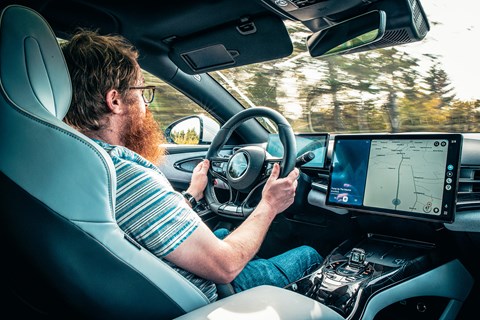
It’s a similar story with the Seal, where there are swings and roundabouts. Same flat floor, slightly less legroom (but still plenty), and a roofline not as swooping as the Hyundai’s. That gives a bit more headroom, making it overall a little better at carrying taller folk. The glass roof stretches over the rear passengers’ heads, and combines with the light interior of our test car to make it feel brighter and airier than the Ioniq’s coal-bunker-inspired hues.
Front space is plentiful, with good head- and legroom plus a wide central armrest to avoid clanging elbows with your front passenger. You’ll find more useful storage spots in the Ioniq 6 thanks to a larger area under the centre console than the Seal. While the Ioniq gets a single wireless phone charger at the base of the dash, the Seal gets a pair within easy reach.
Contrary to what its exterior might suggest, you sit high in the Ioniq, even with the driver’s seat in its lowest position. But that doesn’t mean you get to see the nose of the car, as you might in an SUV; instead, it disappears from view in MPV fashion. The seat bases are quite flat. You can find a good driving position with ease, and most functions are easy to operate on the move.
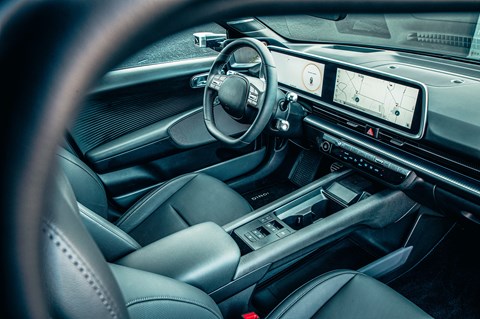
The Ioniq’s physical controls on the wheel are far easier to use than touch-sensitive pads, and there’s a sensible mix of touch and physical controls on the dash. I’d prefer a dial or button for the temperature controls, although at least the icons are separate from the infotainment system.
The Seal feels almost like a sports car in comparison. That’s thanks to a lower driving position made possible by BYD’s clever Blade battery. This is thinner than other packs and forms an integral part of the car’s structure, with the top cover of the battery doubling up as the car’s floor, lowering your seating position. With the peaks of the front wings standing proud and the bonnet in between disappearing off, the view has a hint of sports car, too.
There’s more of a step down into the Seal than the Ioniq 6. The base of the seat is far more sculpted and the head restraints are integrated into the seatbacks, both setting the scene for a far feistier drive than the Hyundai. So too does the stubby drive selector, found in a traditional gearshift location, whereas the Ioniq has a twisting column shift to help declutter and add storage space.
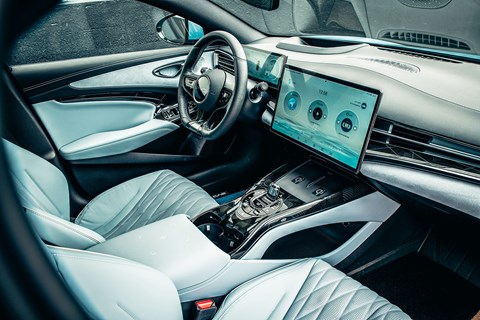
You’ll find a few shortcut icons around the Seal’s gear selector and a couple of rotary wheels to control volume and driving mode, with the steering-wheel spokes also benefitting from buttons. Even so, there is still too much to be controlled by the large rotating touchscreen that’s at the heart of the infotainment system. Portrait mode is supposedly better for maps, but it automatically switches to landscape mode as soon as you run Android Auto or Apple CarPlay.
It’s snappy in its responses and the graphics are sharp, but the heater controls and shortcut bar on the bottom of the display disappear when you’re mirroring your smartphone. With no physical home button, you have to scroll through the app menu to find the BYD icon before you can adjust anything on the car itself through the screen. It’s a small point, but annoying. Still, BYD has a good record of responding quickly when areas for improvement are pointed out, so perhaps this will change soon.
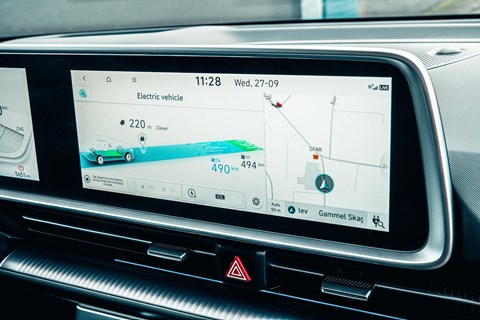
The Ioniq’s infotainment (above) isn’t as big or as flashy, yet it proves to be easier to navigate, with more logically laid-out menus and physical shortcut buttons beneath the screen. The driver’s instruments are bigger and easier to read. Both cars have a head-up display as standard, making it easy to watch your speed without taking your eyes off the road.
Despite its premium-looking list of standard kit, the Ioniq doesn’t feel very fancy in some areas. Apart from a pleasantly squishy armrest, the door card is entirely hard plastic and the silver buttons look a bit cheap. Maybe it’s just me, but in black it’s on the stark side of minimalist; better to go for a lighter alternative. And the door cameras, replacing conventional mirrors, look like an afterthought, and give no compelling reason for shelling out £995.
If anything, the Seal tries a little too hard to look luxurious. We welcome the use of fake leather on the doors and dash, but it comes in two shades, and there are two colours of contrast stitching, plus some fake suede, making it all rather busy. There are also some trim pieces that look piano black in photos, but up close involve intersecting grey and blue lines that are a little ‘try hard’. The BYD doesn’t feel quite as solidly constructed as the Ioniq 6, although to put that in context the Seal gives the impression of being better built than the last Tesla Model 3 I was in.

Quality, comfort and sophistication are all very important considerations in £50k-ish premium saloons, but of course you’ll also want to know about the exciting stuff. How easy is it to get a 3.8-second 0-62mph time out of the Seal? You’ll first need to select Sport mode via one of those scroll wheels next to the gear selector, then find the acceleration timer on the driver’s display using the steering wheel. You’re then told the battery is preparing, although ignoring this message still gives you a rapid start.
For best results, wait for the okay then hold the brake with the left foot, trample the throttle with the right and then let go of the brake. We saw between 3.6 and 3.9 recorded on the Seal’s timer. This is a fast car. Attempts to better 3.6 seconds saw performance slowly tail off despite still having a 45 per cent charge. A a few miles of normal driving restored launch control to its former glory.
There’s no such fuss in the Hyundai: just flatten the throttle for maximum acceleration. In isolation it feels brisk, certainly beyond your typical BMW 330e or Mercedes C220d. Felt after a run in the Seal, it’s significantly less impressive, if still more than potent enough for most people’s needs. It stops well, too. There’s a natural feel to the left pedal, and you can access different regenerative braking levels via paddles behind the steering wheel.
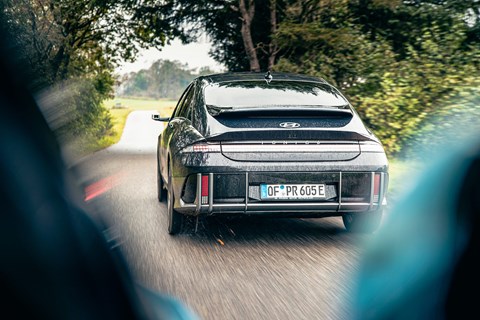
Any suggestions the Ioniq 6 is just a comfortable cruiser evaporate within a short distance. It’s good to drive, firmer than you might expect, with tight damping that keeps its body in check over more challenging stretches of road. There’s enough compliance to take the edge off crumbling urban streets, and although you hear the suspension thudding occasionally, you don’t feel it crashing or banging through potholes.
Similarly, the steering is quicker than you’ll find in the average long saloon, giving a more agile feel than you get in its sister car, the far softer Ioniq 5. There’s a reasonable sense of connection to the front wheels, helping to build confidence in the 6’s abilities. It hangs on gamely during hard cornering without rolling like a ship in sail, and has excellent traction on the way out, too.
It’s a satisfying rather than outright fun car to punt along, but there’s no arguing with the pace at which you can cover ground on rural roads. You can disable the traction control should you wish, revealing a neutral balance that’s almost impossible to upset in the dry. (A two-wheel-drive version with a single motor making 308bhp is also available. It’s significantly slower, but you can still enjoy the odd tail twitch if you’re feeling frisky.)
So dynamically the Ioniq 6 sets a high bar. Can the Seal leap over it? It doesn’t get off to the best start, with gloopy weighting around the straight-ahead marring the steering. There’s more weight and less feel than the Ioniq when you get beyond this, yet it’s precise enough to place the nose accurately and quick enough to not require much arm twirling.
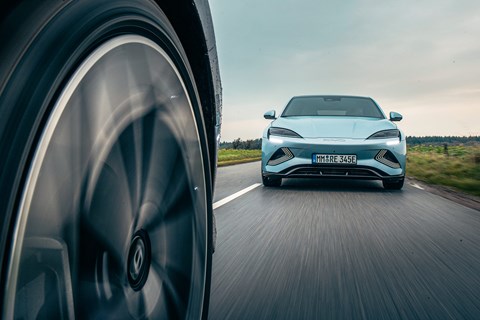
The brakes have good feel and hold up well to fast road driving, although those who like playing with the regen settings will be disappointed to find only two. It’s a softer car than the Ioniq 6, soaking up poor road surfaces with more aplomb if a bit more suspension noise. Body control is a little looser over undulations at speed, yet this is a car that strikes a good balance between ride comfort and handling.
Turn-in isn’t as crisp as in the Ioniq 6, and there’s a bit more bodyroll to contend with. Given the comfort on offer, it’s an acceptable compromise. Traction is more of an issue in the Seal, with the odd glimmer of oversteer possible if you’re heavy-footed out of tight bends. If you’re quick you can apply a touch of opposite lock before the stability control steps in and cuts power. But for the most part the Seal’s chassis seems comfortable dealing with over 500bhp, and its ability to utilise its impressive power reserves in the real world is entertaining.
Both cars come with extensive driver-assistance tech, including lane-keep assist and adaptive cruise control with steering assist. Where other BYDs suffer from over-eager emergency steering assist, the Seal’s systems behave themselves during our driving time, proving just as polished as the Hyundai’s. And that’s really quite something.
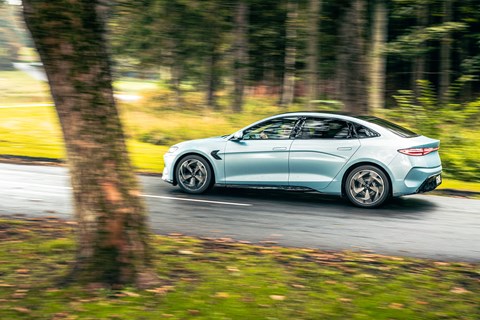
The verdict: BYD Seal vs Hyundai Ioniq 6
Any suspicions that the Ioniq 6 would beat the Seal in category after category have been well and truly banished. These two cars, driven back to back, turn out to be very closely matched.
Previous BYDs have certainly been festooned with equipment, largely inoffensive to drive and thoroughly sensible. What they haven’t been is particularly polished, making it tricky to fully recommend them given pricing that’s competitive but not a downright bargain.
BYD is making rapid progress, though. The Seal is by no means perfect, yet it’s a far more competitive effort than the Atto 3 and Dolphin. It’s also the first BYD to do without ‘Build Your Dreams’ being written in large letters across the rear of the car. A small touch, but it speaks volumes about BYD’s willingness and ability to react to buyer’s demands.
Any concerns that 523bhp would be too much for the chassis are largely unfounded, with the Seal only floundering when the stability control is switched off. Leave it on and there’s enough slack for some amusement, but not enough to get you in trouble. The steering is accurate enough even when pushing on, although the Ioniq feels more natural, especially around the straight-ahead.
Comfort in the Seal is undoubtedly better, and it avoids the under-damped, slightly floaty feel that’s present on the Atto 3 and Dolphin. There’s still an agreeable suppleness, now combined with body control that doesn’t go away when you hit some crests and compressions.
The interior quality impresses, too. Whether the flowing shapes and multitude of materials are to your taste is a different matter, but on the whole it feels like a premium effort, just with a different flavour to the norm.
And while it can’t offer as much rear legroom as the Ioniq 6, the Seal’s superior headroom for those in back makes it a better bet for taller folk. There’s also a lot to be said for a light interior with a massive panoramic roof to give an airy feel, making the Seal a far more pleasant rear space.
It’s a close-run thing, but the Seal’s cheaper price helps push it into first place. The Ioniq 6 certainly hasn’t disgraced itself, but a few areas have been brought into sharp focus. For a car that costs over £50k as tested, the interior feels a bit workmanlike in places. The hard door cards feel like they could have been lifted from one of the more value-orientated models in Hyundai’s range, and rear headroom is tight for the tall.
It’s a slightly more organic-feeling car to drive quickly and is more efficient is normal situations, making it well worth a look if you’d prefer something from a more familiar brand. But having driven them back to back, it’s not the car I’d pick.
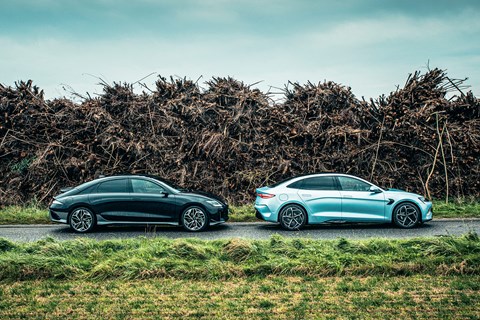
1st: BYD Seal
A quick and comfortable executive EV
★★★★
2nd: Hyundai Ioniq 6
The pricier car. Shame it doesn’t feel it inside
★★★★
BYD Seal specs
Price £48,695 (£49,571 as tested)
Powertrain 82.5kWh battery, dual electric motors, all-wheel drive
Performance 523bhp, 494lb ft, 3.8sec 0-62mph, 112mph
Weight 2185kg
Efficiency 3.4 miles per kWh (official), 323-mile range (official)
Length/width/height 4800/1875/1460mm
Boot capacity 400 litres + 53-litre frunk
Hyundai Ioniq 6 specs
Price: £54,040 (£55,700 as tested)
Powertrain: 77.4kWh battery, dual electric motors, all-wheel drive
Performance: 321bhp, 446lb ft, 5.1sec 0-62mph, 115mph
Weight: 2096kg
Efficiency: 3.7 miles per kWh (official), 322-mile range (official)
Length/width/height: 4855/1880/1495mm
Boot capacity: 401 litres + 15-litre frunk
More comparison tests by CAR magazine